Exam 1 Rules and Definitions Shormann Precalculus
1/363
There's no tags or description
Looks like no tags are added yet.
Name | Mastery | Learn | Test | Matching | Spaced |
|---|
No study sessions yet.
364 Terms
What people group are the oldest know mathematical documents from?
Babylonians (2500 BC to AD 260); not much is known of the pre-flood world.
solute divided by solution x 100
How do you find the % of solute in a solution?
commutative property for addition
if a+b=c, then b+a=c
Difference of 2 squares rule:
a squared - b squared = (a+b)(a-b)
polynomial in more than one unknown
one term, or a sum of individual terms of the form ax^n y^m z^p..., where a is a real #, x,y,z, etc. are unknown quantities, and n,m,p, etc. are whole #'s.
"What 2 factors, when multiplied together equal 'c', and when added together equal 'b'?"
What question can you think about when factoring a quadratic polynomial?
Equation of a line in General form
Ax + By + C = 0
fundamental theorem of algebra
any polynomial of degree 'n' has 'n' complex roots; NOTE: real #'s are also complex #'s if the form a+bi. In other words, the imaginary part =0
line
a width-less length; its location is represented on paper by using a pencil and straight edge.
perpendicular bisector of a chord theorem
if any segment 'AB' passing through the center, 'A', is drawn perpendicular to any chord 'j', then it bisects the chord. The converse is also true: if any segment 'AB' passing through the center bisects any chord 'j', then it is perpendicular to the chord.
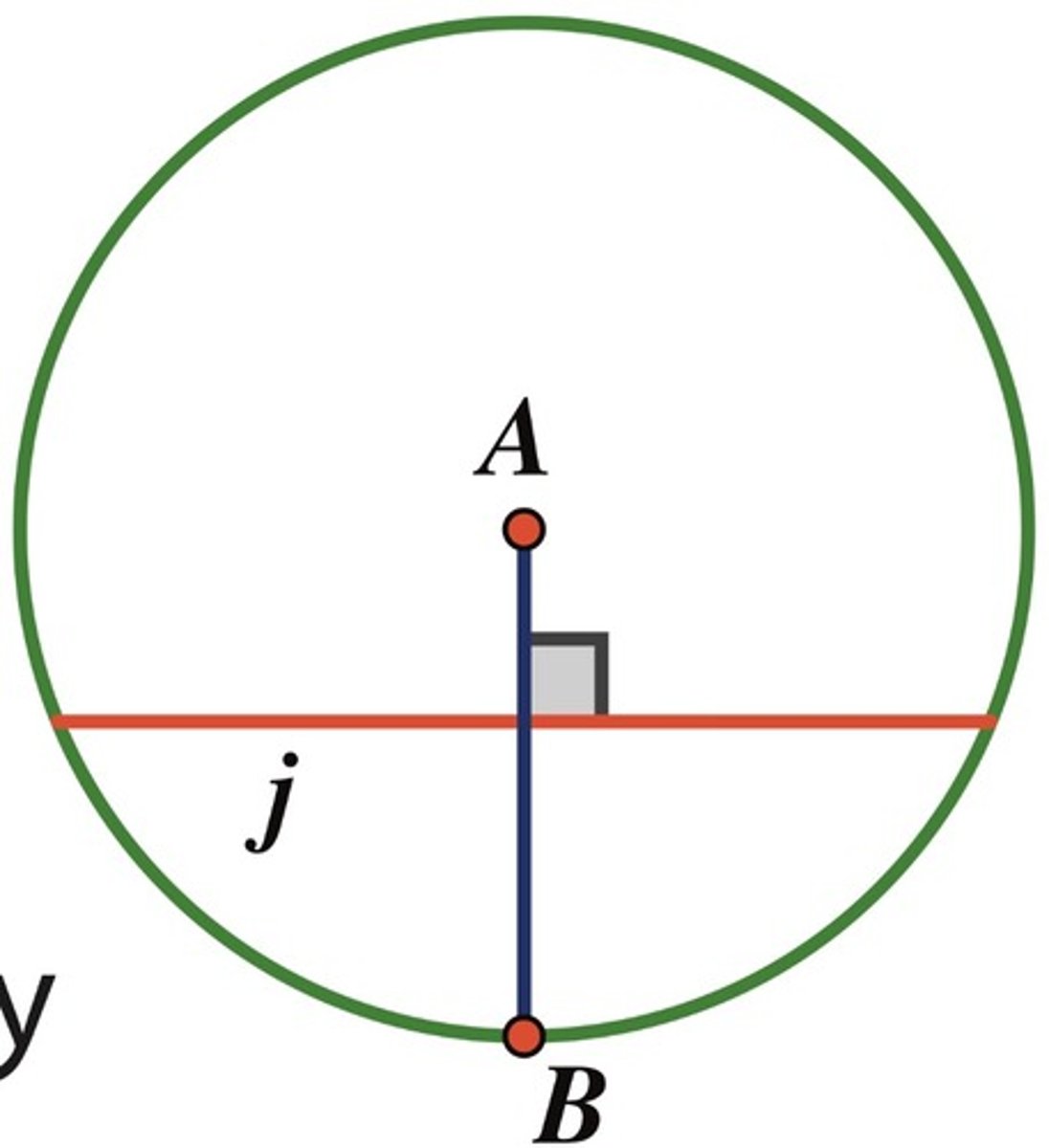
linear function graph
Name the type of function shown
f(x) = x:
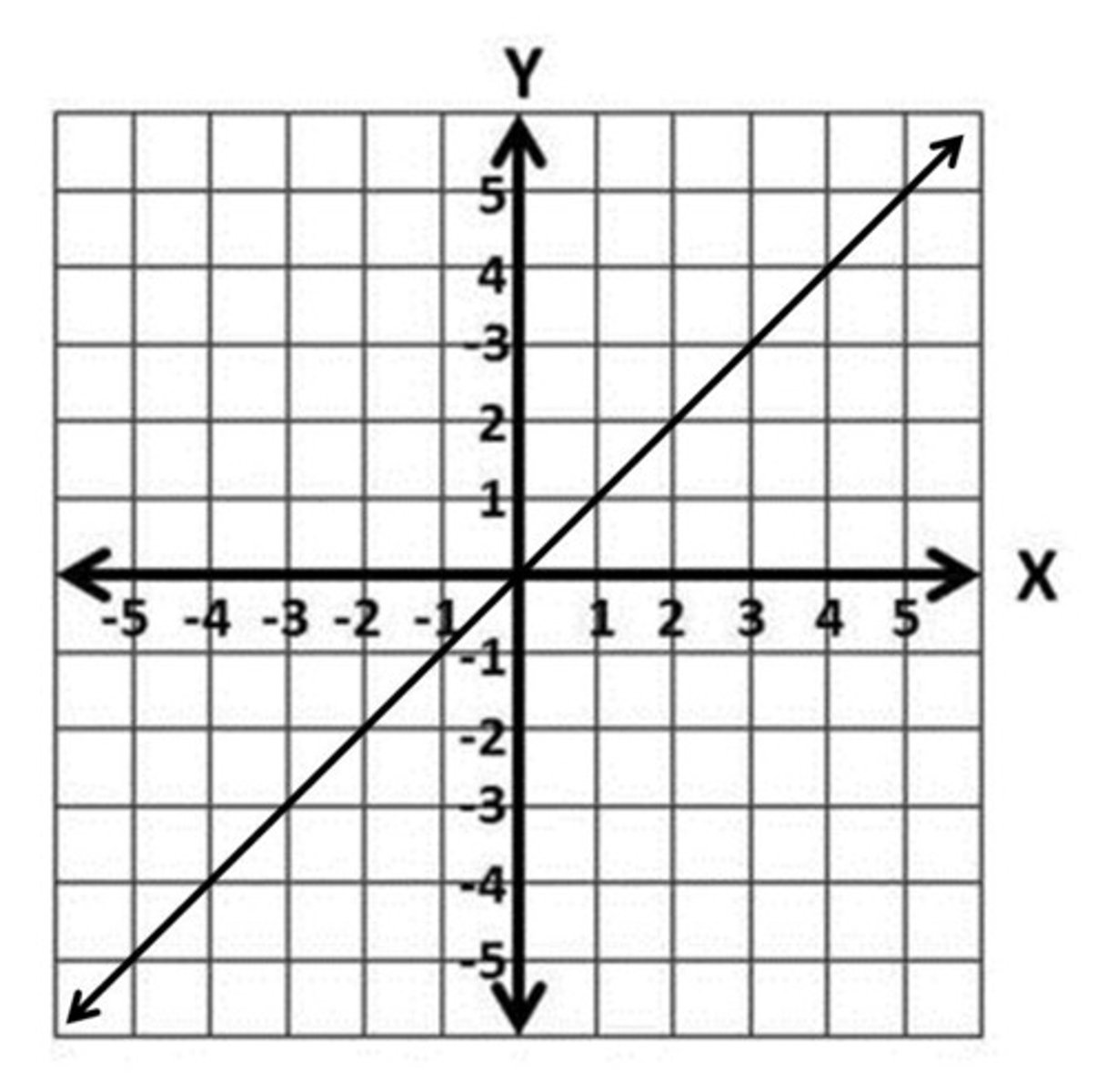
logarithmic function graph
name the type of function shown f(x)=log (sub b)times x for b>1
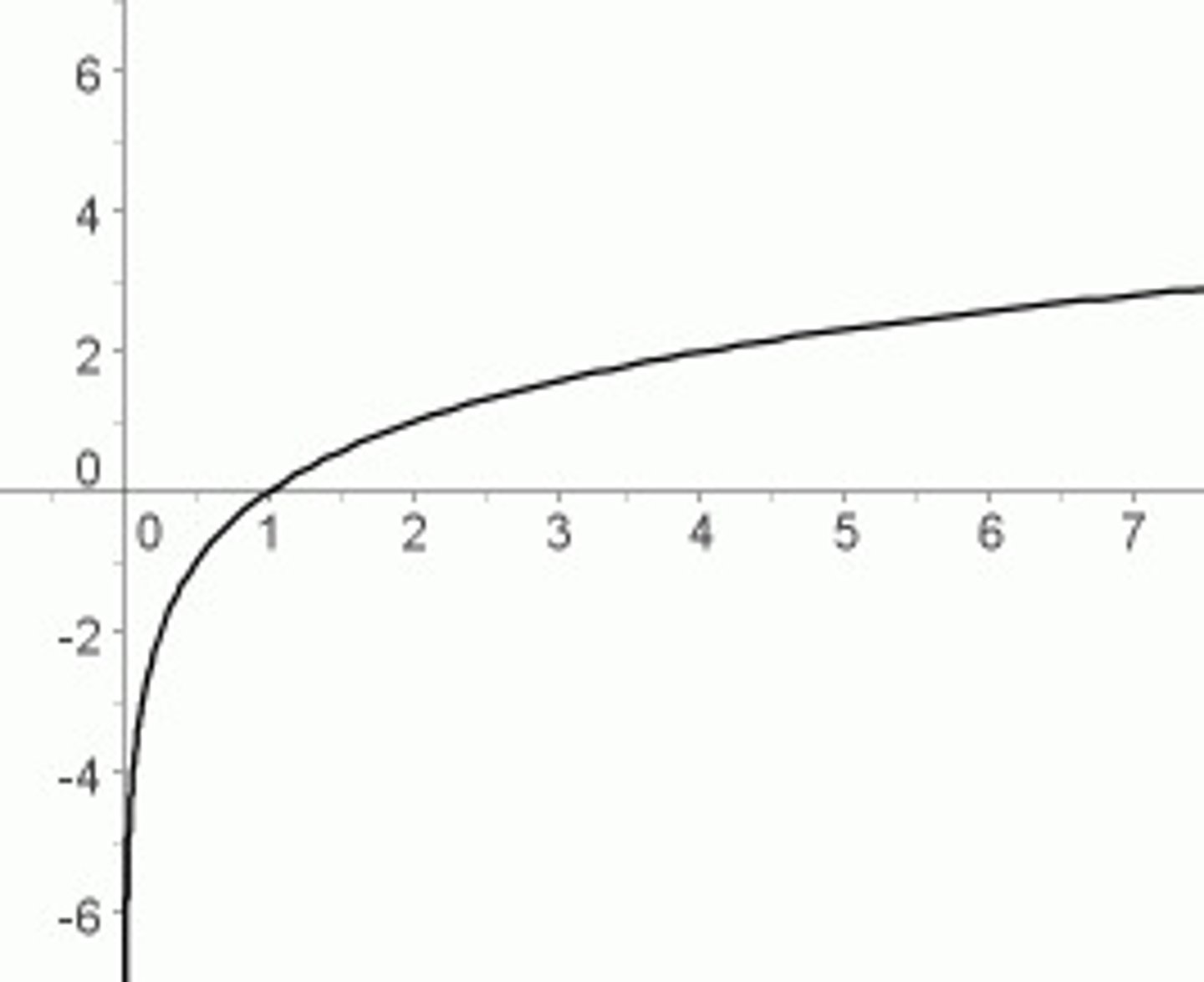
quadrant
the 4 parts of a coordinate plane, as described below:
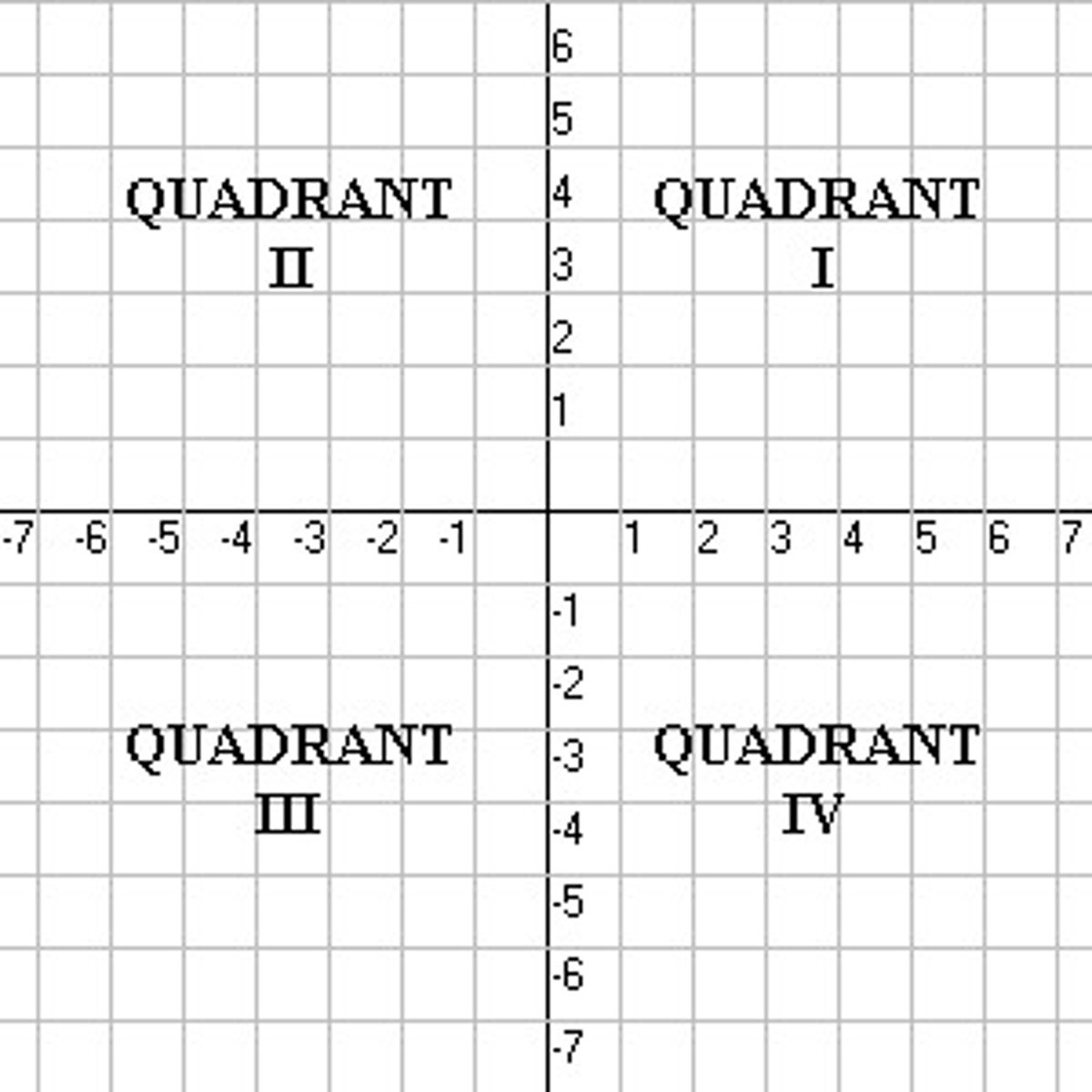
inverse sine function
opposite/hypotenuse
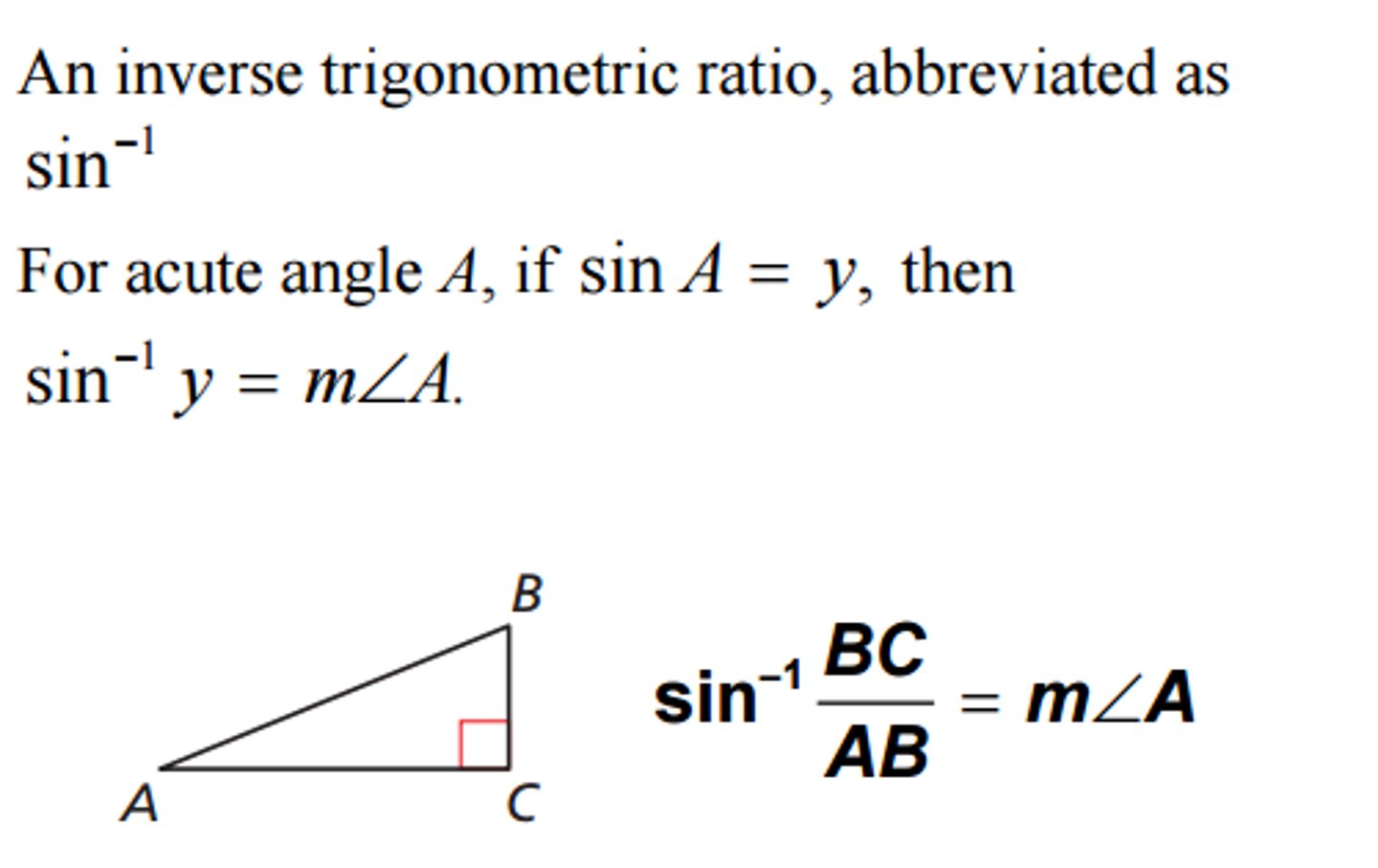
Parallelogram Law
the sum, or resultant, of any two vectors equals the diagonal of a parallelogram whose sides equal the magnitudes and directions of the 2 vectors.

Steps to convert from Rectangular to Polar Coordinates:
1. Get your bearings (draw the vector on a coordinate plane)
2. Draw a right triangle, marking the magnitude, M and direction, 'theta'.
3. Find M using the distance formula.
4. Find 'theta' using the inverse of tangent, recording its actual value relative to the positive x-axis.
5. Write answer in the form M angle (theta).
disjoint sets
two sets that have no elements in common
union
when referring to 2 sets, {A} & {B}, where all #'s belong to both sets. When both sets have an identical #, it is only included once when describing this.
intersection
when referring to 2 sets, {A} & {B}, where only the #'s that the sets have in common is referred to.
mass divided by volume
How do you calculate density?
sas
2 triangles are similar if the lengths of 2 corresponding sides are proportional, and the angles between those sides are congruent: side, angle, side
vertex
where 2 polygon sides, or 2 angle rays, meet
cone
a solid with a circular base and a lateral surface that comes to a point
sphere
a solid, which is the set of points a given distance from a given point called the center
deductive reasoning
the process of applying rules. Mathematics is deductive. There are mathematical rules yet to be discovered.
hypothesis
the premise or initial facts started with the "if" statement. In science courses, it is often referred to as an educated guess.
A3
From Euclid's 5 axioms, or common notions:
If equals be subtracted from equals, the remainders are equal.
If a=b and c=d, then a-c=b-d
horizontal line test
a graph on a coordinate plane is a one-to-one function if a horizontal line intersects the graph at only one point.
slope
a ratio expressing the change in the dependent variable (y) with respect to the independent variable (x). Also referred to as "rise over run", "change in y over change in x", and "delta 'y'/delta 'x' where "delta (triangle shape)" = "change in".
ratios of 45-45-90 right triangle
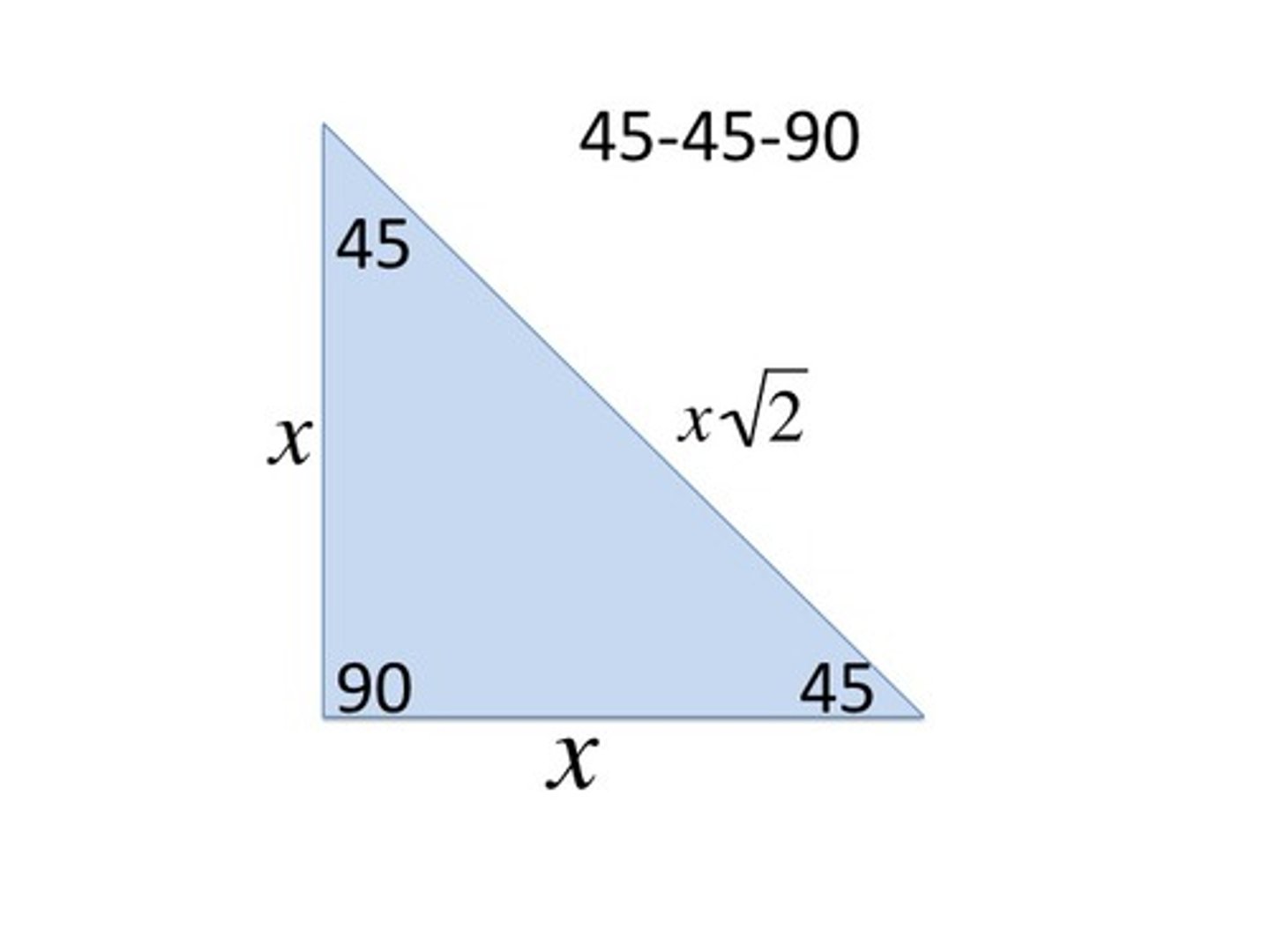
polar form
a way to represent a vector by its magnitude (M) and direction (degrees-"theta"). Often written using the notation M (angle) "theta"
30-60-90 triangle
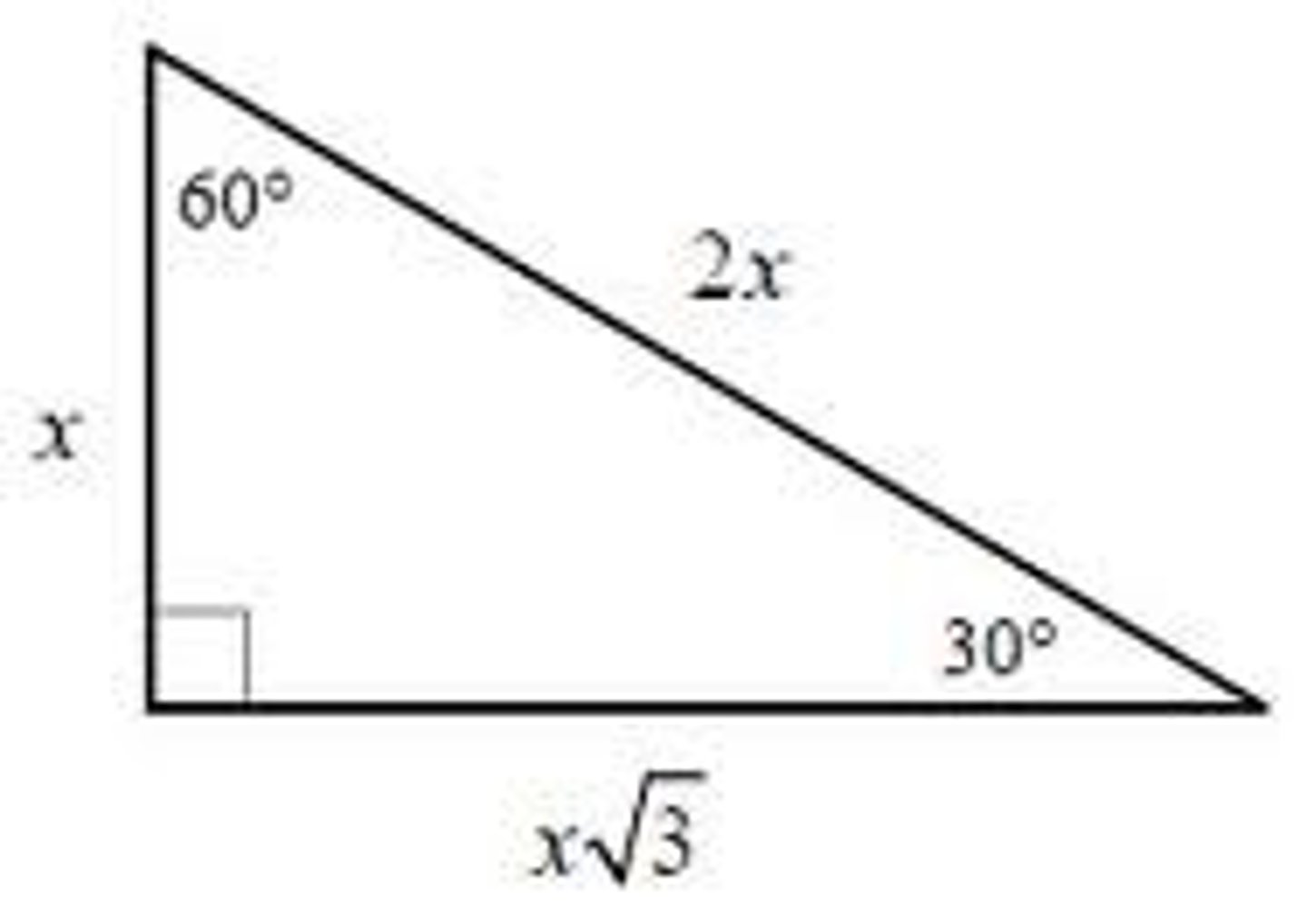
infinitesimally
a quantity whose value is decreasing without bound. The idea that a value can be close to, but not equal to, zero. super small change; instantaneous.
inductive reasoning
the process of discovering rules.
deductive reasoning
the process of applying rules
numeral
a symbol or symbols used to express the idea of #
abstract
dealing with the properties & ideas of things
concrete
a word used to describe real objects; abstract ideas are always based on real things.
digit
any of the Hindu-Arabic numerals 1-9, and 0
natural #'s
counting #'s; 1,2,3...etc.
whole #'s
counting #'s & zero
integers
whole #'s & all negative #'s
real #'s
any number used to describe a positive or negative #; includes all integers & all decimal & fractions.
rational #
a # that can be written as a fraction of integers
irrational #
a # that cannot be written as a fraction of integers; have non-repeating decimal patterns
trichotomy axiom
for any 2 real #'s and b, exactly one of the following is true:
a<b a=b a>b
square root
if x is greater than 0, then the square root of x is the unique positive real # such that the square of the square root of x = x.
imaginary #'s
the result of taking the square root of a negative number. Normally the square root of -1 is factored out and exchanged for the symbol "i". i squared = -1
complex #'s
numbers that have a real part & an imaginary part: ex. a+bi
note - all real #'s are complex with b=0
subset
a special group of elements that is entirely contained within a larger set.
logic
the art of reasoning well.
idea
a number is an _______.
mathematics
This is Dr. Shormann's definition of what term:
"_______ is the language of science and a God-given tool for measuring and classifying pattern and shape."
{}
this represents a 'set' of things
U
union of 2 sets
upside-down U
intersection of 2 sets
empty set; null set
An "o" with a diagonal line through it
vertical line '|'
means "such that"
A fancy, bold 'N' represents what in set notation?
"the set of natural #'s"
A fancy, bold 'Z' represents what in set notation?
"the set of integers"
A fancy, bold 'Q' represents what in set notation?
"the set of rational #'s"
A fancy, bold 'R' represents what in set notation?
"the set of real numbers"
universal set
The enclosing rectangle of 2 sets depicting a Venn diagram; maybe illustrating an intersection or union.
Jeremiah 33:3
"Call unto me, and I will answer thee, and shew you great and mighty things which thou knowest not." (KJV)
sexagesimal
the base 60 numeral system which we still use today (60 seconds in a minute, 60 min. in an hour, 360 degrees in a circle.) This originally comes from the ancient Babylonians.
one
Any # divided by itself equals what?
1/x
What is the reciprocal of x?
Logarithm rule
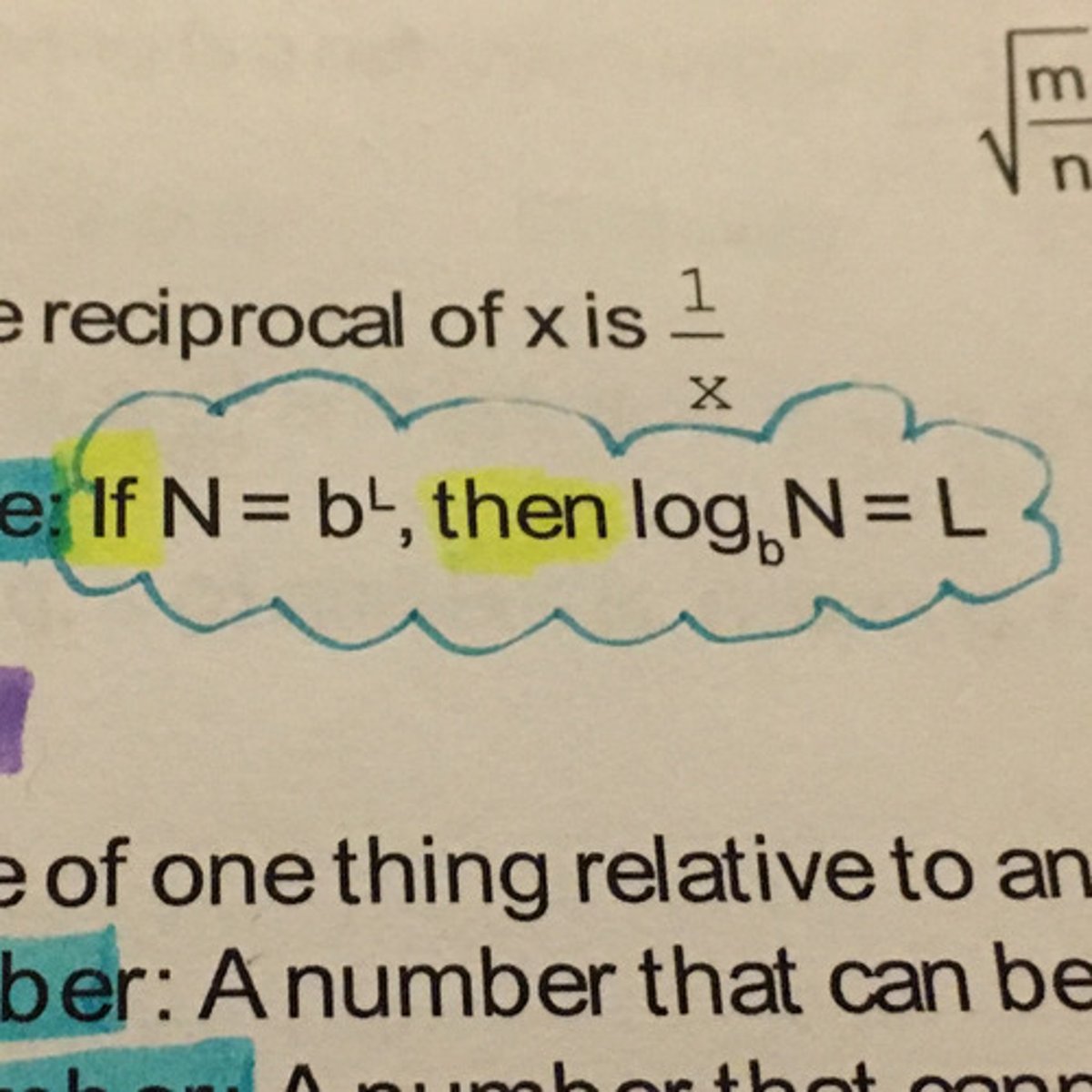
ratio
the size of one thing relative to another.
fraction
part of a whole; a numerical quantity that indicates division of one # by another.
prime #
a # that is only divisible by itself & 1, such as 2,3,5,7 etc.
numerator & denominator
What is the "top" and "bottom" # of a fraction respectively?
logarithm
in any exponential relationship of the form N=b to the 'L' exponent; 'L' can be referred to as the _______ of N
proportional
having a constant ratio
analogy
resemblance in some particulars between things otherwise unlike; similar
Logos
the original Greek manuscripts used this in place of 'Word'
proportion
equal ratios
circumference divided by the diameter of a circle
Where does the calculation for "pie" come from?
Natural log is also called Log 'e'. What is it's value and where is this # used?
the 'e' is named for the scientist, Euler. Euler's # is approximately = to 2.718 and is used in science, specifically in biology to measure bacteria.
Log 10 & Log 'e'
What are the 2 most commonly used logarithms?
distance divided by time
How do you calculate rate?
1000 grams
What does 1000mL of water weigh?
commutative property of multiplication
if ab=c, then ba=c
associative property for addition
(a+b)+c = a+(b+c)
associative property for multiplication
(a times b)c = a(b times c)
distributive property
a(b+c) = ab + ac
additive identity
a+0=a ; any # plus zero equals that #
multiplicative identity
a(1) = a ; any # times 1 equals that #
power rule for exponents
if m and n are real #'s and x does not = zero, then
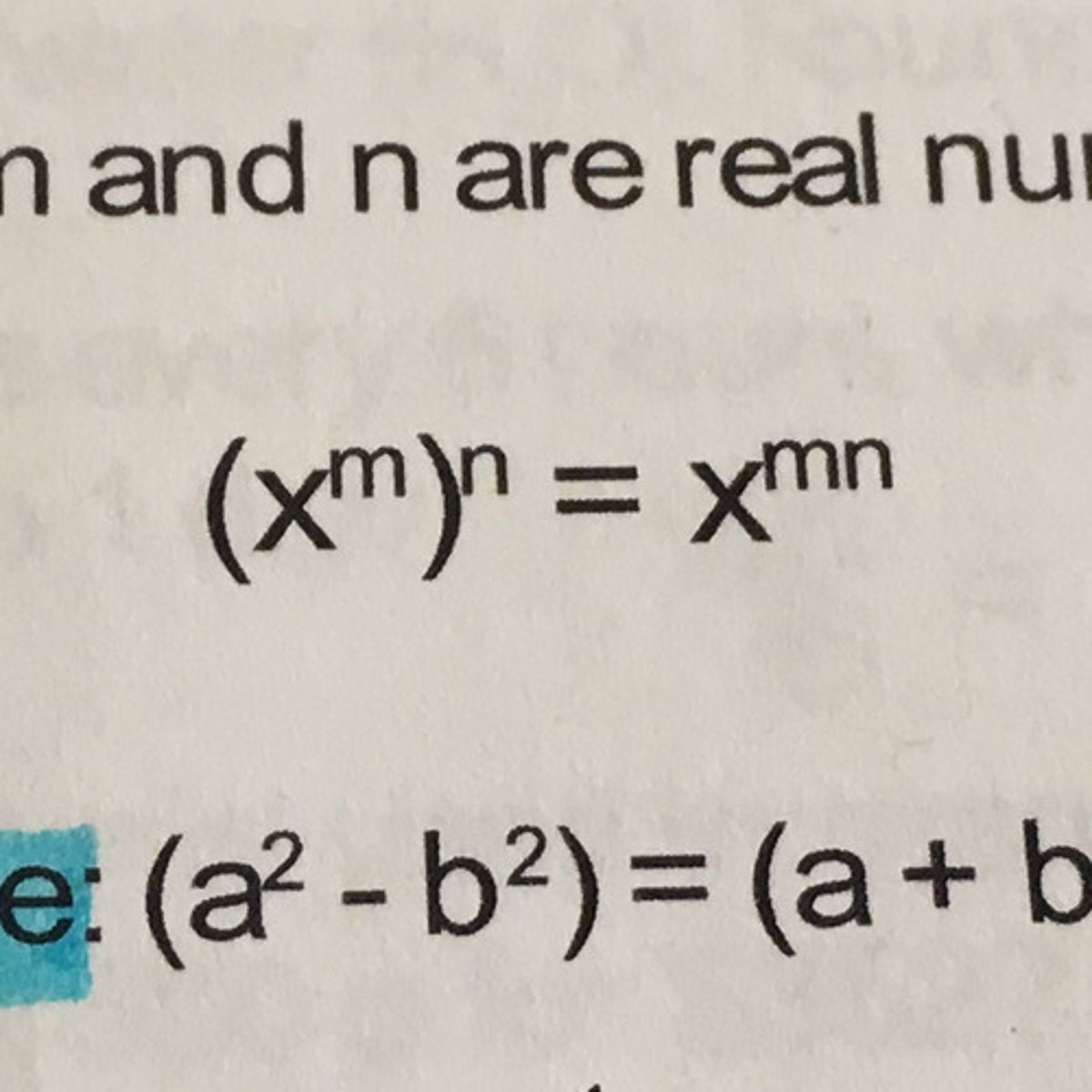
Logarithm Laws:
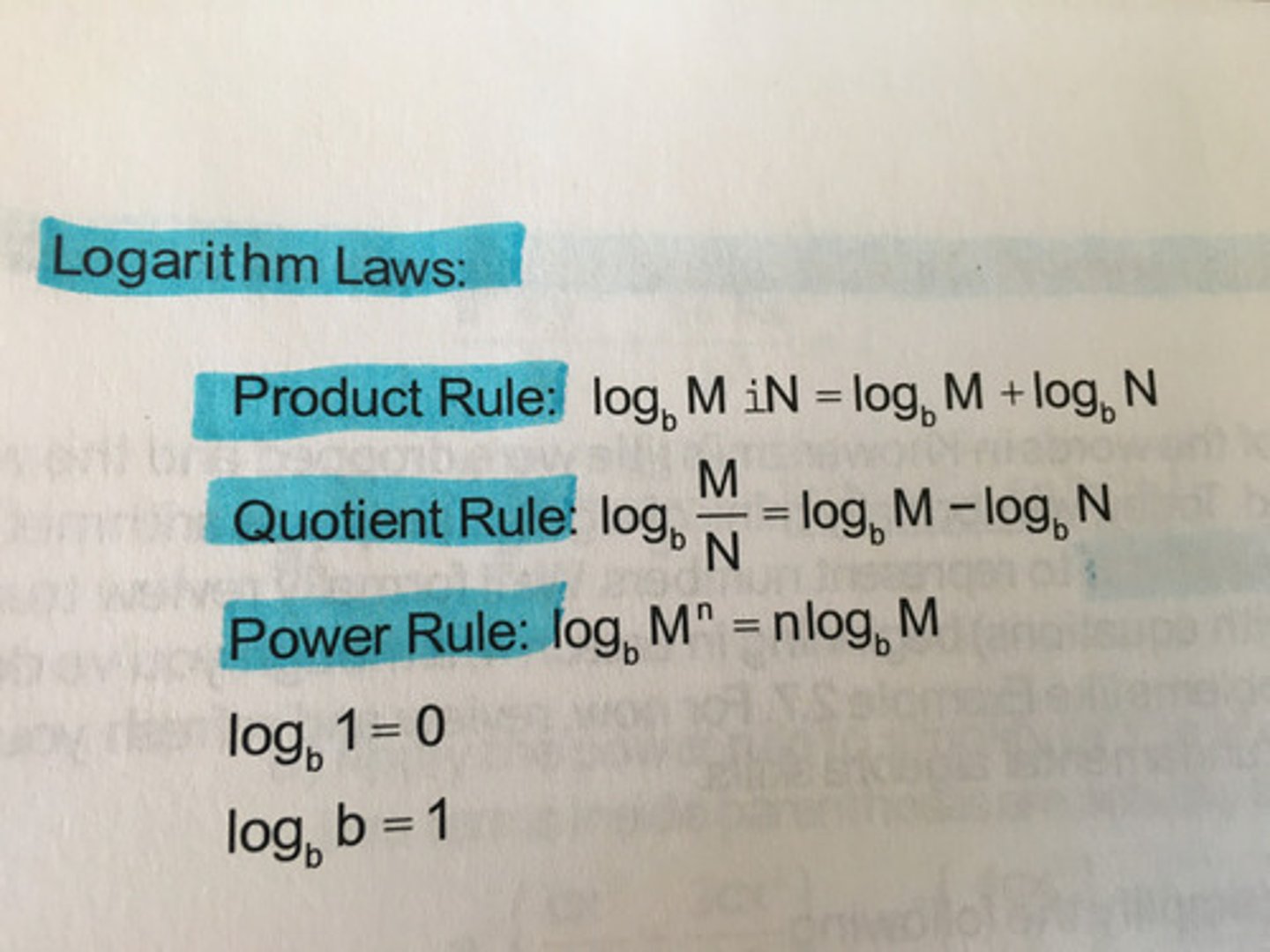
algebra
a generalization of arithmetic, where letters representing #'s are combined according to the rules of arithmetic, often to solve for a unknown value
one
in algebra, you don't have to write the 1 (one)
polynomial in one unknown:
one term, or a sum of individual terms of the form ax^n, where a is a real #, x is an unknown quantity, and n is a whole #.
Hisab al-jabr
a book written by Islamic astronomer meaning "science of transposition & cancellation." This is where we get 'algebra' from. (sound it out)
additive property of equality
if a, b, and c represent real #'s, and if a=b, then a+c=b+c also: c+a=c+b
multiplicative property of equality
if a, b, and c represent real #'s, and if a=b, then ca=cb also: ac=bc
and: a/c = b/c
parallel lines
"train tracks" have the same slope
perpendicular lines
where 2 lines cross making 4 right angles; these lines have slopes that are negative reciprocals of each other
slope
a ratio expressing the change in the dependent variable (y) with respect to the independent variable (x). Also referred to as "rise over run", "change in y over change in x"; also:

delta
"change in"